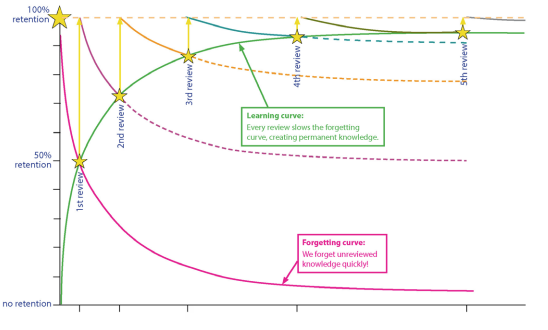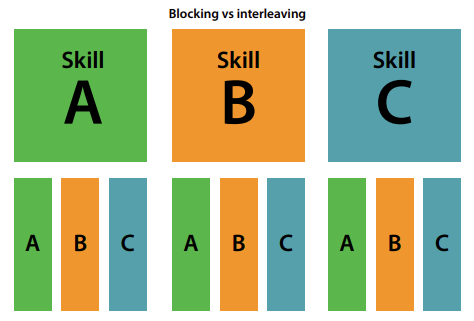Spaced review and interleaving: An introduction
23 May 2023
Nicola Heath, Psychology Subject Advisor

Spaced review and interleaving are great tools to use in your classroom. In this blog I’ll explain the key ideas behind each and how they can be useful and effective for helping your students recall information long term. I will also provide a short summary for students that explains how they can use this to enhance their revision.
What is spaced review?
Many teachers find that supporting students in recalling the content for exams is challenging. Whilst students can do well in short-term recall tests, they find it challenging to recall content later in the year – or indeed in the exam. Spaced review is a method that takes advantage of how our memory works to increase the accuracy and detail of recall.
Research such as that by Kelley and Whatson (2013) has suggested extremely quick reviews of course material improves memory recall rapidly and that by getting students to revisit material every 10 minutes, with distractor tasks in between, we could revolutionise the way students learn.
Spaced review is a technique that can also be embedded over a longer period using the same principles of repetition to strengthen long-term memory recall. The principle underlying this is that students are using maintenance rehearsal to revisit material over time and thus strengthen the memory trace.
Ebbinghaus in 1885 suggested understanding how forgetting occurred could aid efforts to improve learning. He suggested that if you ‘overlearn’ material you are less likely to forget it later. We can use this principle to support students in preparation for exams by building in repetition into schemes of learning.

As you can see from the above diagram, the typical forgetting curve (in pink) occurs after the initial presentation of new material. There is a steep decline in retention and within a short amount of time if this content is not revisited or recalled the memory will quickly fade. This makes future recall much harder.
The principle of spaced review is to encourage the semi-regular review of content over time. The retention of this information will then become increased and recall much easier. This is shown by the shallower forgetting curves and the green learning curve that shows a strengthened recall after each review. An easy way to explain this to students is that your memory is like a muscle and the more you use it to recall a piece of information, the stronger it will be next time.

What is retrieval practice?
When you start to research spaced review, retrieval practice is often cited alongside. These terms are often used interchangeably but there is a subtle difference. Spaced review can be the combination of teaching topics over a period of time as well as providing students opportunities to recall and apply prior knowledge. On the other hand, retrieval practice concentrates much more on students recall of knowledge over time.
With retrieval practice the emphasis is on quick recall tasks that are no-stakes. The outcome of retrieval practice is not to mark work or provide a grade. The recall tasks should be non-threatening to students and not known in advance as we don’t want them to revise the night before and simply use their short-term memory.
What is interleaving?
Interleaving, otherwise known as distributed practice, is a method used to revisit learning, put spaced review into practice and improve memory recall.
As Pan (2015) says ‘Mixing it up boosts learning’ compared to more traditional methods of block learning where students master one topic before moving on to the next in preparation for exams.
As you can see from the diagram below, learning is spread over time rather than concentrating on narrow topics one after the other.

How does interleaving work?
There are a few theories about the cognition behind interleaving. A few ideas according to Pan (2015) are:

The beauty of interleaving is that you can embed it as little or as much as you like and tailor the interleaving to your students. The diagram above suggests mixing topics up entirely, which can prove highly effective. You can also mix blocking most of your lesson content with interleaved homework tasks that complement current learning and develop deeper understanding of prior topics.
How to plan and deliver using these methods
Students are often aware of material they have already covered and one challenge we face as teachers is how to make the material engaging whilst interleaving concepts and repeating exposure to material. The key to interleaving over time and embedding spaced review is developing material that is challenging and engaging. To get started it can be useful to take one topic and break it down into sections. As these should be related to each other, it can enhance the interleaving process as you being to teach all sections in and around each other.
The aim of spaced review is to ‘pick and mix’ activities to suit your learners and build up their knowledge. These could range from short questions to longer more reflective pieces of synoptic content such as essay questions or responses to a stimulus. Each week, a lesson or homework task could have an element of prior recall which will aid retention long term. By embedding these strategies in your curriculum, you will deepen students’ knowledge whilst improving their long-term memory recall.
You could you break down each topic into subtopics and create a table that maps when you will go back to this information with your students. This could be across a term, a year or even the entire course. Revisiting a subtopic doesn’t need to be a big task; a MCQ or short question could be enough to get your students thinking. However, this can be very time consuming to begin with and you may prefer to use a set of random questions which should eventually cover the course over time.
A popular retrieval practice technique is to use a series of MCQs at the start of a lesson that could cover any content they have previously been taught and works well with this idea of random questions. Boxer calls this a Do Now task and gives some tips on how to do this in this blog post. If you are able to generate a series of questions, Boxer explains how to use his template to create a random question generator for each lesson.
This can all seem quite daunting at the start, but in Agarwal et al.’s (2021) literature review of retrieval practice, they conclude that even a small amount of spaced or retrieval practice will add benefit to students learning. They encourage teachers to try to adopt some of these methods and not worry too much about the timing or number of activities.
Student focus: How to use an interleaving method for revision
Are you cramming for an exam or assessment? Have you found it challenging? Interleaving is a method to use when revising to help you remember more for the exam and to understand it better as well!
By revisiting material from each topic several times, in short bursts, you can increase the amount you remember in the exams. The forgetting curve shows us that we forget a lot of the information we learn if we don’t revisit it at all. Each time you revise information it strengthens your memory recall as you can see by the ‘learning curve’.
When planning revision try to break units down into small chunks and split these over several days rather than cramming one topic all at once. This can mean doing just 10 minutes revision for each subject in a revision session and then the next day covering a different subtopic for each subject again. You can create a revision timetable like the one below to organise your time so you can space revision from the whole course right up to the exam.
|
Week 1 |
Week 2 |
Week 3 |
Week 4 |
Week 5 |
Week 6 |
| Subtopic 1 |
Mon – 10 mins |
|
Mon – 10 mins |
|
Mon – 10 mins |
|
| Subtopic 2 |
|
Mon – 10 mins |
|
Mon – 10 mins |
|
Mon – 10 mins |
| Subtopic 3 |
|
|
Mon – 10 mins |
|
Mon – 10 mins |
|
| Subtopic 4 |
|
|
|
Mon – 10 mins |
|
Mon – 10 mins |
Remember that revision is about recalling information you already know, it shouldn’t mean hours of reading per subtopic. Instead, test your recall with flashcards or try an exam question. Then you can identify any gaps in your knowledge that you need to address.
Find out more about spaced review and interleaving
The following websites, articles and videos provide more detail about the role of spaced review and interleaving and how these techniques can improve recall long term.
Stay connected
Have you tried introducing spaced review or interleaving into your teaching? Let us know in the comments below. If you have any questions, you can email us at psychology@ocr.org.uk, call us on 01223 553998 or tweet us @ocr_psychology. You can also sign up to subject updates and receive information about resources and support.
About the author
Nicola joined OCR in 2022 as the Subject Advisor for Psychology. Prior to joining OCR, she taught psychology for over 10 years and had various other responsibilities in that time including being Head of Year and Subject Leader for PSHE. Nicola has a personal interest in mental health and wellbeing and enjoys reading, baking and spending time outdoors to relax.